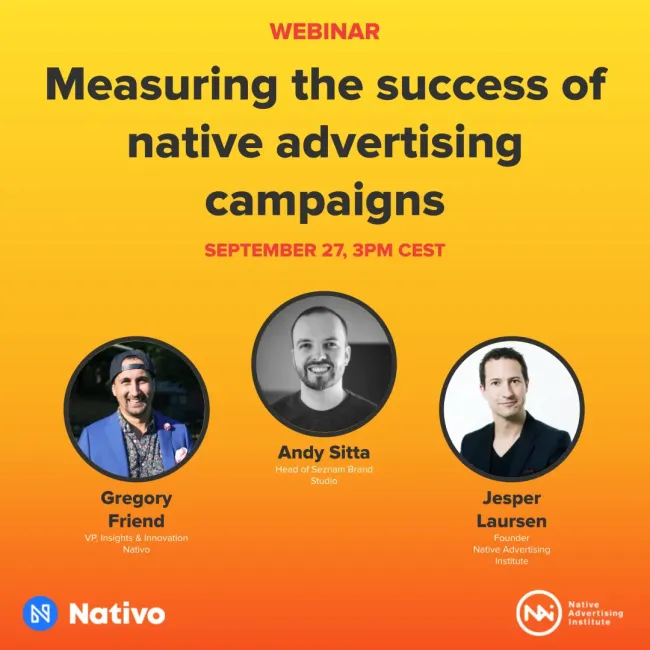
 Details
Details
Native advertising makes sense. In a world where consumers have lost their tolerance for intrusive marketing and clumsy banner ads, and respond better to personalisation and ongoing brand relationships, branded content has emerged as a much-needed alternative.
However, for advertisers and publishers who historically relied on user views to demonstrate campaign success, native ads present a challenge. How can the impact of this approach be measured? We spoke to some of our customers about the value of branded content, how it can be evaluated, and where they believe the future lies for native advertising.
Native Advertising's Impact on Publisher Strategies
For many publishers, branded content is already showing its potential to drive significant results for clients, as well as arming the publisher with first-party insight to enable them to create and distribute relevant, engaging content.
“Branded content is a cornerstone of our commercial strategy and in recent years, native advertising has become a key contributor to our digital growth,” says Ørjan Norbom, head of commercial analysis and insight at Amedia in Oslo.
And for those for whom branded content does not yet play such a central role, the feedback shows that its usage is increasing - and will continue to do so.
Advertisers are demonstrating a growing interest in alternative ways to get the brand message across, and to connect with potential audiences in meaningful ways. Native ads offer exactly that, and support the long-game when brand uplift is the desired outcome: “In the last two years, we more than doubled our income from branded content. Focusing on the brand metrics of preference, and consideration, will show better performance,” explains Feiko Backhaus, marketing manager at Funda in Amsterdam.
Measuring Success: Key KPIs for Branded Content Campaigns
While not all publishers or campaigns will be driven by the same priorities, the KPIs used to evaluate success do tend to fall under the categories of qualitative or quantitative measurements. The former tend to be the attention-oriented statistics such as CTR, dwell time or bounce rate. The latter might centre instead on reach or number of unique users.
Yet advertisers are also increasingly offering a more bespoke approach, especially as they integrate more native advertising and branded content into their campaign strategies. For example, one of the key factors used by Hello! magazine to measure the efficacy of a native partnership is action intent. They are not alone in taking a more nuanced outlook:
“We have evolved our approach to emphasise a deeper understanding of what drives successful outcomes. We now prioritise brand lift measurements and analyse the overall impact of native ads”, explains Norbom.
The Power of Brand Lift in Campaign Effectiveness
Brand lift measurement has the potential to transform the way in which marketers demonstrate campaign effectiveness and choose their strategic partners. Indeed, for some publishers, this unique data already plays a key role in helping to prove success, and crucially also drives ongoing client relationships.
In the context of native advertising, this data becomes a commercially important differentiator for publishers. As Hello! Creative Content Director Arianna Chatzidakis explains, “The results allow us to see how our campaigns have enabled our brand partners’ standing in comparison to competitors, and to prove how their partnership with Hello! has helped improve these results.”
Publishers tell us that using brand lift measurement during campaigns can also highlight where there is a need to focus more on mid-funnel metrics and to adapt strategies in-flight. For Marcin Nietrzebka, head of marketing analysis at Axel Springer Poland, “when campaigns show little to no results on brand standings and brand lift at this stage, we can improve campaigns by recommending the addition of branded content”.
The Future of Native Advertising: Growth and Innovation
As awareness of the value of native advertising grows, so do the solutions and technology available to evaluate its impact. Mechanisms - and partners - that measure brand uplift metrics are a natural pairing with advertisers using branded content and native ads, helping to demonstrate the value of these ads for their intended purpose, driving quality engagement and longer-term consumer relationships.
But how do publishers anticipate native advertising will grow in the near future? In some markets, native ads and branded content are still in their infancy, but as such, already represent an opportunity for those venturing into this type of strategy.
Poland is one such example, as Nietrzebka explains: “The branded content segment is rather niche in the Polish market at the moment, but is a product category that is growing exceptionally”. He continues, “Brand lift studies for branded content campaigns illustrate our uniqueness among digital publishers in the Polish market.”
Norwegian media group Amedia, on the other hand, continues to experience robust year-over-year growth in branded content and expects to see an increase in the production of contextual and audience-targeted content at scale in 2025.
Native ads deliver higher ROI than display. The key to successfully incorporating native and branded content lies in the metrics, with all parties in the campaign lifecycle having access to consistent measurement data. For the publisher in particular, it is this which will demonstrate competitive advantage, and ultimately deliver better overall performance for their clients in the long term.

Discover Key Findings on Native Advertising Metrics
On 31st October 2024, Brand Metrics will present the findings of our whitepaper, The metrics that matter, in an exclusive webinar, Does native advertising really work?, in partnership with Native Advertising Institute.
Thanks to our valued clients Hello! Magazine, Axel Springer, Funda and Amedia for sharing their thoughts on measuring the impact of native advertising with Brand Metrics.





